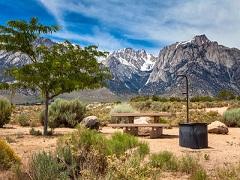Inyo National Forest and Bureau of Land Management Bishop Field Office Enter Fire Restrictions
Organization:
BLM Office:
Media Contact:
The Inyo National Forest and Bureau of Land Management Bishop Field Office are implementing (Stage 1) fire restrictions effective on all Federal lands under their jurisdiction. This decision is based on very high fire danger, drought conditions coupled with extremely dry vegetation, an increase in human caused wildfires and the availability of firefighters for response.
Seasonal fire restrictions for the Eastern Sierra Region are being implemented in close coordination with the Cal Fire San Bernardino/Inyo/Mono Unit and the Mono County Sheriff’s Office. Effective May 24, 2021, and until further notice, the following restrictions will be in effect:
- No Campfires, briquette barbeques, or stove fires are allowed outside of fire rings or fire pits at designated developed recreation sites. The list of designated campgrounds and recreation sites is available at visitor centers and is posted here for Inyo National Forest and available here for the BLM Bishop Field Office.
- Valid California Campfire Permits are Required (available free of charge at U.S. Forest Service visitor centers, BLM and CalFire offices, or online at www.readyforwildfire.org/permits/campfire-permit/ and are not exempt from the prohibitions, but are allowed to use portable stoves or lanterns using gas, jellied petroleum, or pressurized liquid fuel.
- No Fireworks. It is prohibited to possess or discharge any fireworks, including “safe and sane” fireworks.
- No Smoking, except within an enclosed vehicle or building, a developed recreation site, or while stopped in an area at least three feet in diameter that is barren or cleared of all flammable material.
- No tools powered by internal combustion engines off designated roads or trails (such as chainsaws or lawn mowers).
- No motorized vehicles off designated roads or trails.
- No welding or operating acetylene or other torch with open flame.
Resorts, pack stations, recreation residences and other sites operated under special use permit from the U.S. Forest Service may be exempt from the special orders, as long as any fire activity is conducted in compliance with their permit and only at the site of their permit. These are listed here.
- Residents and visitors are reminded that simple steps can help prevent human-caused fires.
- Prevent vehicle related fires by maintaining proper tire pressure, ensuring adequate tire tread, and checking your brakes for overheating. Avoid traveling or parking on brush or grass. Ensure chains are not dragging while towing.
- Make sure your campfire is dead out! Drown it, stir it, feel it. If it’s not cool to the touch, it isn’t out.
- Use of exploding targets, such as Binary Explosive Targets, incendiary, steel jacketed or armor piercing ammunition and tracer rounds, while recreationally shooting is both a fire hazard and illegal. The use of steel-core ammunition, although legal, can greatly increase the chance of a wildfire.
- Hunters actively engaged in the legal pursuit and take of game and non-game species must have a valid California hunting license and abide by California laws and regulations.
- Motorcycles, ATV’s and chainsaws require an approved spark arrestor.
Anyone found guilty of violating a fire prevention order may be fined not more than $100,000 and/or face imprisonment for not more than 12 months. Restitution for total fire suppression and damage costs incurred may be borne by the trespasser.
Help prevent wildfires … One Less Spark, One Less Wildfire.
The BLM manages about 245 million acres of public land located primarily in 12 western states, including Alaska, on behalf of the American people. The BLM also administers 700 million acres of sub-surface mineral estate throughout the nation. Our mission is to sustain the health, diversity, and productivity of America’s public lands for the use and enjoyment of present and future generations.

